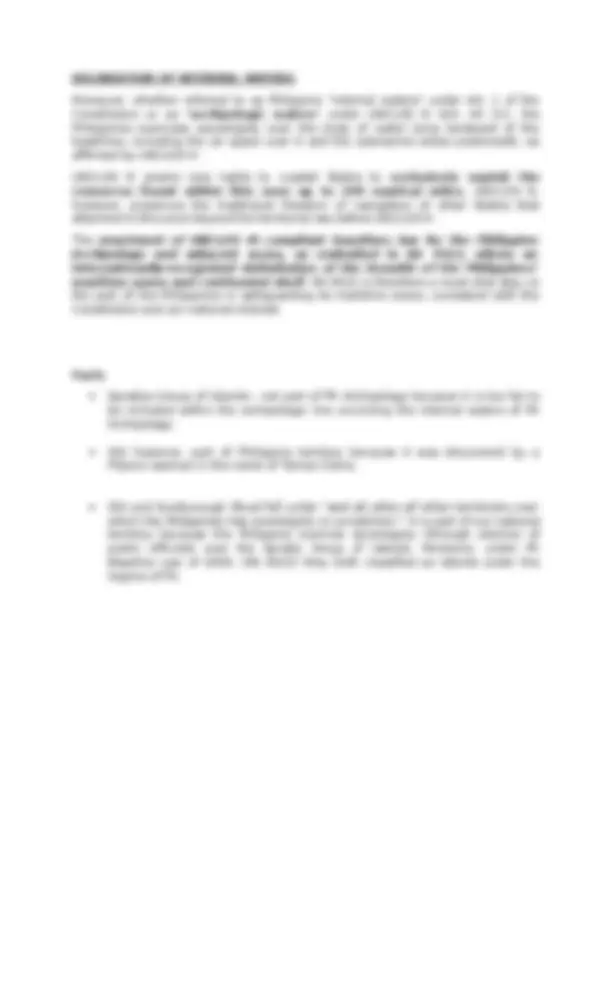




Study with the several resources on Docsity

Earn points by helping other students or get them with a premium plan


Prepare for your exams
Study with the several resources on Docsity

Earn points to download
Earn points by helping other students or get them with a premium plan
Community
Ask the community for help and clear up your study doubts
Discover the best universities in your country according to Docsity users
Free resources
Download our free guides on studying techniques, anxiety management strategies, and thesis advice from Docsity tutors
Case Digest for Magallona v Ermita Constitutional Law I National Territory
Typology: Summaries
1 / 4

This page cannot be seen from the preview
Don't miss anything!



Prof. Merline M. Magallona et al., v Hon. Eduardo Ermita et al., G.R. No. 187167, July 16, 2011 En Banc, Carpio, J., Facts RA 3046 was passed and followed the framing of UNCLOS I, demarcating the maritime baselines of the Philippines as an archipelagic State. It remained unchanged for nearly 5 decades. Codifying the sovereign right of States parties over their territorial sea. In 2009, Congress amended the law by enacting RA no. 9522, prompted by the need to make RA 3046 compliant with the terms of UNCLOS III. UNCLOS III prescribes the water-land ratio, length, and contour of baselines of archipelagic States like the Philippines and sets the deadline for the filing of application for the extended continental shelf. R.A. No. 9522 shortened one baseline , optimized the location of some basepoints around the Philippine Archipelago and classified adjacent territories, namely, the Kalayaan Island (KIG) and the Scarborough Shoal , as "regimes of islands" whose islands generate their own applicable maritime zones. Naturally formed area of land, surrounded by water, which is above water at high tide. Petitioners, professors of law, law students and a legislator file a petition for certiorari and prohibition, assailing the constitutionality of R.A. No. 9522 on several grounds:
UNCLOS III has nothing to do with the acquisition (or loss) of territory. It is a multilateral treaty regulating, among others, sea-use rights over maritime zones (i.e., the territorial waters [12 nautical miles from the baselines], contiguous zone [24 nautical miles from the baselines], exclusive economic zone [200 nautical miles from the baselines]), and continental shelves that UNCLOS III delimits. On the other hand, baselines laws such as RA 9522 are enacted by UNCLOS III States parties to mark-out specific basepoints along their coasts from which baselines are drawn, either straight or contoured , to serve as geographic starting points to measure the breadth of the maritime zones and continental shelf. UNCLOS III and its ancillary baselines laws play no role in the acquisition, enlargement or, as petitioners claim, diminution of territory. Baselines laws gives notice to the rest of the international community of the scope of the maritime space and submarine areas within which States parties exercise treaty-based rights, namely, the exercise of sovereignty over territorial waters (Article 2), the jurisdiction to enforce customs, fiscal, immigration, and sanitation laws in the contiguous zone (Article 33), and the right to exploit the living and non-living resources in the exclusive economic zone (Article 56) and continental shelf (Article 77). WEAKENS OUR TERRITORIAL CLAIM Petitioners' assertion of loss of "about 15,000 square nautical miles of territorial waters" under RA 9522 is similarly unfounded both in fact and in law. On the contrary, RA 9522, by optimizing the location of basepoints, increased the Philippines' total maritime space (covering its internal waters, territorial sea and exclusive economic zone) by 145,216 square nautical miles. What we call the Kalayaan Island Group or what the rest of the world call the Spratlys and the Scarborough Shoal are outside our archipelagic baseline because if we put them inside our baselines we might be accused of violating the provision of international law which states: "The drawing of such baseline shall not depart to any appreciable extent from the general configuration of the archipelago." So sa loob ng ating baseline, dapat magkalapit ang mga islands. Dahil malayo ang Scarborough Shoal, hindi natin masasabing malapit sila sa atin although we are still allowed by international law to claim them as our own. Far from surrendering the Philippines' claim over the KIG and the Scarborough Shoal, Congress' decision to classify the KIG and the Scarborough Shoal as "Regime of Islands under the Republic of the Philippines consistent with Article 121" of UNCLOS III manifests the Philippine State's responsible observance of is pacta sunt servanda obligation under UNCLOS III.
Moreover, whether referred to as Philippine "internal waters" under Art. 1 of the Constitution or as " archipelagic waters " under UNCLOS III (Art. 49 (1)), the Philippines exercises sovereignty over the body of water lying landward of the baselines, including the air space over it and the submarine areas underneath, as affirmed by UNCLOS III. UNCLOS III grants new rights to coastal States to exclusively exploit the resources found within this zone up to 200 nautical miles. UNCLOS III, however, preserves the traditional freedom of navigation of other States that attached to this zone beyond the territorial sea before UNCLOS III. The enactment of UNCLOS III compliant baselines law for the Philippine Archipelago and adjacent areas, as embodied in RA 9522, allows an internationally-recognized delimitation of the breadth of the Philippines’ maritime zones and continental shelf. RA 9522 is therefore a most vital step on the part of the Philippines in safeguarding its maritime zones, consistent with the Constitution and our national interest. Facts Spratlys Group of Islands - not part of Ph Archipelago because it is too far to be included within the archipelagic line encircling the internal waters of Ph Archipelago SGI however, part of Philippine territory because it was discovered by a Filipino seaman in the name of Tomas Cloma. SGI and Scarborough Shoal fall under "and all other all other territories over which the Philippines has sovereignty or jurisdiction." It is part of our national territory because the Philippine exercise sovereignty (through election of public officials) over the Spratly Group of Islands. Moreover, under Ph Baseline Law of 2009, (RA 9522) they both classified as islands under the regime of Ph.